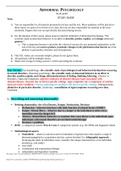ABNORMAL PSYCHOLOGY Study guide Note: 1.You are responsible for all material presented in lecture and the text. More emphasis will be placed on those topics we spent a lot of time on in class, but you are also responsible for material in the texts (textbook, Popper) that was not specifically discussed during lecture. 2.For the duration of this course, please keep in mind the definition of Abnormal Psychology: “the scientific study of abnormal behavior in an effort to describe, predict, explain, and change abnormal patterns.”
a.This is important because it provides the criteria of success for any proposed explanation: at the end of the day, we want to produce systematic changes in the phenomena that interest us , from phobias to personality disorders and schizophrenia. 3.The D2L videos are extremely helpful, please do not ignore them. 4.All questions will be multiple choice. 5.Please don’t forget to bring a pencil. I will be providing the scantrons. Key Terms: Psychopathology- the scientific study of psychological and behavioral dysfunction occurring
in mental disorders , Abnormal psychology- the scientific study of abnormal behavior in an effort to describe, predict,explain, and change abnormal patterns of feeling, thinking, behaving ., Disease vs. Disorders, Signs and Symptoms- objective indicator of disorder/disease//state associated with disorder/disease- disorder has no known specific etiology ; signs symptoms not a component of another more pervasive condition .// disease pathological condition with known specific etiology, Pathognomonic- distinctive of particular disorder , Syndrome,- constellation of signs/symptoms occurring over time , Treatment 1.Describing and measuring abnormality
Defining abnormality: the 4 Ds (Distress, Danger, Dysfunction, Deviance
oDysfunction – behavior interferes with daily function. (Cultural factors ADHD?)
oDanger- Mental illness – behavior that is a danger to the individual or others (how immediate must the danger be?)
o Distress- Mental illness behaviors or emotions that cause disress to the individual( spme individuals with mental disorders are not distressed(schizopgr oDeviance- ( problems
DSM – a categorical system: Pros & Cons of categorical systems (e.g. the DSM) and diagnostic labels Methodological aspects oNomothetic – relates to universal and to formulation of general laws that explain a range of phenomena(applied to a population that has a given disorder) Vs . Idiographic approach – involving the study of individual cases; considers the unique characteristics of an individual person(e.g. case study)
ocase study
ocorrelational and experimental designs oindependent and dependent variables This study source was downloaded by 100000831963712 from CourseHero.com on 01-27-2022 14:29:39 GMT -06:00
https://www.coursehero.com/file/13675695/Abnormal-Psychology-Study-guide-Exam-1/STUDY GUIDE oexperimental and control groups the purpose of control groups is to rule out alternative explanations; the placebo effect is only one of the potential variables that could account for the observed differences.
oblind and double-blind designs
ospecial experimental designs: quasi-experimental, natural experiment, analog experiments, single-subject design (baseline-based)
Assessment methods (interview, cognitive testing, personality testing, response inventories, neuropsychological testing, neuroimaging) – brief, I will not be asking for details
Statistical properties of measures
oreliability (test-retest, internal consistency, split-half, inter-rater), ovalidity (face, concurrent, predictive, construct), Note: In single-subject designs (heavily used by behaviorists), the comparison is between baseline condition(s) and manipulation conditions. A classic example : implement extinction to get rid of tantrum. Step 1: take baseline measurement: measure frequency and intensity f tantrums before any strategy is deployed. Step 2: assume that “getting his way” is what maintains the behavior. Withhold it (extinction) and observe what happens with frequency and intensity. Step 3: you want to make sure other variables were not at play, so put “get his way” if you were right, you should see a return to baseline, to the initial frequency and intensity (this is equivalent to having a control group in regular experimental designs).
Step 4: take it away again (extinction again)
2.Explanations (or paradigms, or models) oSomatogenic & Psychogenic perspectives (just the definitions, the distinction is outdated)
oCurrent models (assumed causes, proposed interventions): a)psychodynamic (conflicts, defense mechanisms, projective techniques) b)biological (drugs, ECT, psychosurgery) c)behavioral (see the basic mechanisms of change, below)
d)cognitive (faulty cognition patterns, cognitive therapy)
e)humanistic (conditions of worth and Roger’s client-centered therapy)
Speaking of Humanism and Carl Rogers, what are conditions of worth? Could it be that the mechanisms through which they are acquired are the basic mechanism of change? (e.g. making affection contingent on a certain class of operands, like cleaning
room? Could it be that what is happening “behind the scenes” is taking a resource that should be delivered unconditionally (e.g. parental safety, warmth , etc.) and making it contingent on behaviors? Food for thought.This study source was downloaded by 100000831963712 from CourseHero.com on 01-27-2022 14:29:39 GMT -06:00
https://www.coursehero.com/file/13675695/Abnormal-Psychology-Study-guide-Exam-1/




